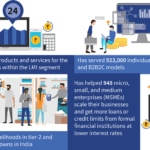Financial Health and the Coronavirus: Another Failure to Prepare
Like a well-plotted mystery, the story of how the novel coronavirus is affecting our world adds a new chapter every day. From today’s vantage point, no one can see how it will turn out. One thing that is clear, however, is that the financial health of many if not most of the world’s people will plummet, with lasting consequences for individuals, families and the global economy.
Financial health, as defined by the Financial Health Network, a U.S. nonprofit, “comes about when your daily financial systems allow you to be resilient and pursue opportunities over time.”
Going into the crisis, the state of individuals’ financial health around the world was surprisingly precarious. Only in a few high income/high equality countries are a large majority of people financially healthy – such as Norway, with a median score of 86 out of 100. In many other high income countries – including the U.S., U.K., Ireland and Australia – somewhat more than half are financially healthy. It’s downhill from there, especially in countries with lower per capita incomes and higher income inequality. For example, Gallup found that in the following countries, very few people were financially secure: Bangladesh and Colombia (7%), Kenya (9%), Chile (10%), Vietnam (11%) and Greece (12%).
Focusing on resilience in the face of shocks, Gallup asked people how long they could live if their income stopped – by drawing on reserves or selling something. The percentage of people who said their resources would last less than one month was 51% in Chile, 47% in Kenya and 61% in Vietnam. The gist of these findings is corroborated by other studies and in other countries. In several Latin American countries, CAF, Development Bank of Latin America and BBVA Research found that 20% couldn’t make their resources last for more than a week. It is a stark reality that living on the edge of a financial cliff is standard for people everywhere, especially for people with lower incomes. And this precarious state is an enormous source of stress and worry for those on the edge.
So, countless people around the world lack the resources to last even one month without income. Yet the timeline for the pandemic to complete its cycle during which movement limitations are likely to be imposed is at least three months – or longer. This mismatch promises to greatly increase the impact of this crisis on vulnerable and even not-so-vulnerable people, even after the health impact has subsided, and to leave people unprepared to restart their economic lives.
How the timing mismatch of financial resilience and the progress of the pandemic will play out depends on the measures policymakers take, both in restricting movement to combat the virus and in providing economic relief. Economic losses will come in the form of unemployment, the collapse of small businesses and health crises, and it is easy to see that they will not be evenly distributed: Some people will suffer great losses; others will maintain their positions. Many people in less formal economies turn to family and friends in time of crisis, but in this crisis, everyone faces the same challenges, depleting their ability to assist others. While it is certain that the poor will be more affected and less able to cope, some low-income groups, like the urban self-employed, may suffer greater loss of income than, say, small farmers.
If financial health had been a greater policy priority, policymakers would have been more prepared for the economic side of this crisis. They would have been urging and supporting people to build a financial cushion. They would have enacted stronger health financing safety nets, so that catching the virus would be a health crisis, but not an economic one.
Today, deciding whether to lean toward harsher measures to stop the virus or to favor economic activity is a matter of heated debate, with pundits furiously arguing from either side. (Unfortunately, the experts in this trade-off, epidemiologists and economists, don’t necessarily share the same language or the same priorities.) What is crystal clear, however, is that governments and other capable organizations must urgently provide relief efforts, and these must be targeted toward those who are both most likely to suffer disruption and least resilient. Given the severity of the crisis, these measures will stretch treasuries to their limits.
Once we are past this crisis and begin to write the epilogue, we hope to see that policymakers around the world have learned the lesson that financial health is of urgent importance. We hope the pandemic will place financial well-being firmly on national and international agendas, and that policymakers will begin to measure it on a regular basis – to take the financial temperature of the population. And we hope they will establish goals and design programs to help people restore their financial health.
Elisabeth Rhyne is a consultant with the insight2impact program, and former Managing Director of the Center for Financial Inclusion. Insight2impact is a NextBillion partner.
Photo courtesy of MemoryCatcher.
- Categories
- Finance




